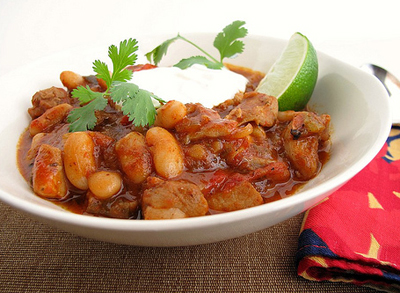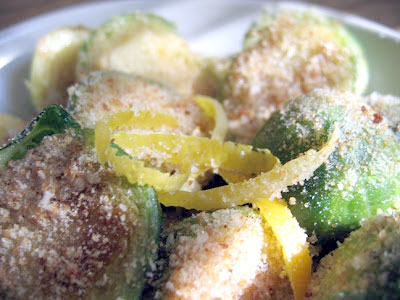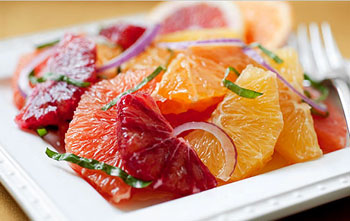 I can't think of a better food for the cold days upon us than a big bowl of comforting chili. There is something special about the heat of chile peppers that has a rightful place in this stew. Chili is a great dish for bringing people together and it can feed a crowd very easily. This recipe can be doubled or tripled. It's perfect for when you have group of friends over for game-watching on Super Bowl Sunday. The best part about a recipe like this is that it can be prepared in advance and simply reheated when it's time to serve. No one needs to slave away at the stove and miss watching the game.
I can't think of a better food for the cold days upon us than a big bowl of comforting chili. There is something special about the heat of chile peppers that has a rightful place in this stew. Chili is a great dish for bringing people together and it can feed a crowd very easily. This recipe can be doubled or tripled. It's perfect for when you have group of friends over for game-watching on Super Bowl Sunday. The best part about a recipe like this is that it can be prepared in advance and simply reheated when it's time to serve. No one needs to slave away at the stove and miss watching the game.
Chiles, specifically chile powder or dried chiles, are the key ingredients in making a robust and flavorful chili. But I go further than that and jazz things up with a combination of fresh peppers in varying stages of hotness. I like poblanos for their grassy flavor, red bell for their sweetness, cubanelle for their mild fresh flavor, and jalapeños for the kick. I broil the peppers until their skins blacken and blister. Not only does this step add flavor, it's nicer to eat the chili once the peppers have had their papery skins removed. The hotness of the jalapeños is also tamed by broiling, so the chili doesn't scream hot, but instead it hums.
Winter
Winter
Finally...It's Bean Season
From the LA Times
 Some people mark the start of fall with an apple pie. Others start breaking out the big reds from their wine cellars. Me? I'm a bean boy.
Some people mark the start of fall with an apple pie. Others start breaking out the big reds from their wine cellars. Me? I'm a bean boy.
All it takes is the first sign of a nip in the air or the first morning that smells like ocean rain and I drag my Dutch oven out of the cupboard and start a big pot of beans simmering.
It doesn't really matter that I know the next day may be back up in the 90s. In fact, that uncertainty even makes it a little sweeter.
That week of rain we had at the end of September? A Portuguese-style stew of white beans with shrimp and clams, given a final lift by chopped pickled peppers.
A week or so later, after the 100-degree temperatures had lifted? White beans braised with dandelion greens and served as a bed for crisp-skinned duck breasts (the leftovers, without the duck, were just as good a couple of nights later, with a few tablespoons of grated Parmigiano-Reggiano stirred in).
Brussels Sprouts on Botox

Not so at the cruciferous vegetables table. There lie the Brussels sprouts, kale, cabbages, broccoli, and cauliflower (of which only the funky Romanesco variety is getting any attention). These uncomely vegetables patiently wait for someone to come by and check them out. It is a long wait.
This past Sunday the Brussels sprouts were carelessly dumped in a lop-sided pile, causing stray runaway sprouts to keep rolling off the table's edge and onto the concrete. Inspired by Molly’s witty post at Orangette, I thought I would take on a challenge. A makeover for three undatable vegetables: Brussels sprouts, cauliflower, and broccoli. The make-up? Breadcrumbs.
Cheesy-Buffalo Roasted Cauliflower-Potato Soup
 Yes, the title is a mouthful, but let me just say, every component plays an integral part in this AMAZING soup.
Yes, the title is a mouthful, but let me just say, every component plays an integral part in this AMAZING soup.
And straight from the mouth of my cauliflower-hating husband..."Hunna (he calls me hunna) when you have guests over, THIS soup has to be on the menu. It has to be "the soup", as in our house soup. One that never-ever goes away." Yep, that's how good it is. This comes from the man that hates cauliflower. He won't let me steam it in the house because it smells so bad. Roasting on the other hand doesn't release those stinky smells and makes the cauliflower taste wonderful.
There is something about this soup that gives it the perfect mouthfeel. The buffalo sauce just adds some awesome highlights and spice.
I highly suggest making a big pot for Super Bowl, it will disappear. And if you happen to serve it with my Easy Artisan Bacon-Cheese Bread, you might hear angels sing. I'm just sayin...
Allowing Citrus to Add Sunshine
From the New York Times
 Good citrus can almost make you glad it’s winter. When it’s in season — that’s now — it’s equal or superior to anything else you can buy in the plant kingdom. Any way you can devise to eat it, you’re taking advantage of something at its peak.
Good citrus can almost make you glad it’s winter. When it’s in season — that’s now — it’s equal or superior to anything else you can buy in the plant kingdom. Any way you can devise to eat it, you’re taking advantage of something at its peak.
This citrus salad requires only that you overcome the notion that salads must be green; it’s a novel and wonderful antidote to sorry-looking lettuce.
If you’re lucky and can find blood oranges, use them; same with the odd, supremely delicious and usually quite pricey pomelos.
The idea is a combination of grapefruit (I like pink), oranges (navels, though common, are still terrific) and tangerines or clementines: pretty much any citrus fruit that’s more sweet than sour.
More Articles ...
Welcome to the new One for the Table ...
Our Home Page will be different each time you arrive.
We're sure you'll find something to pique your interest...


